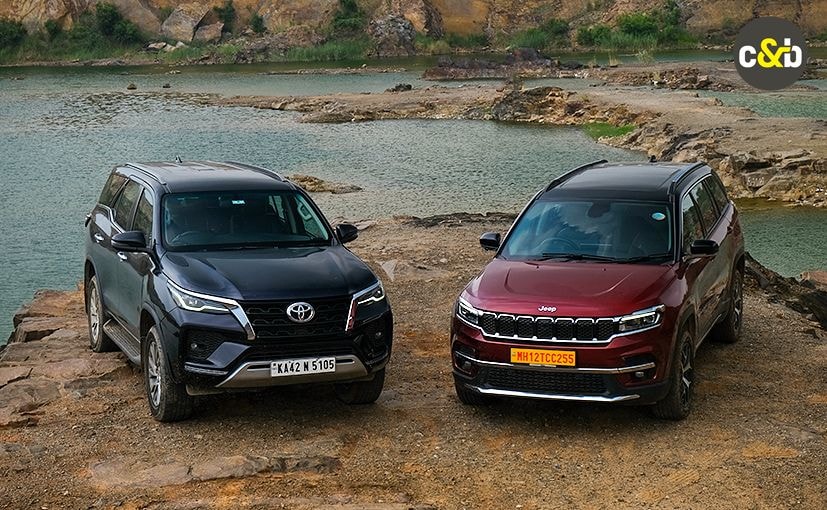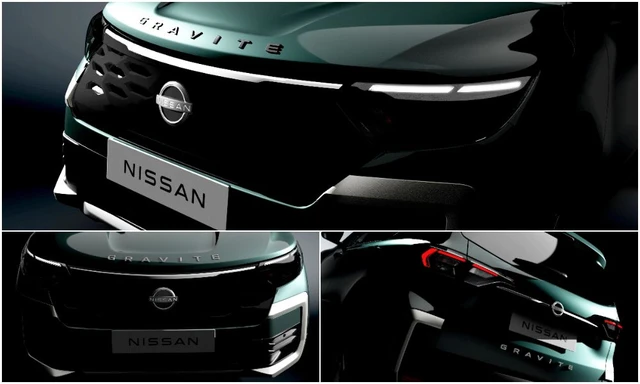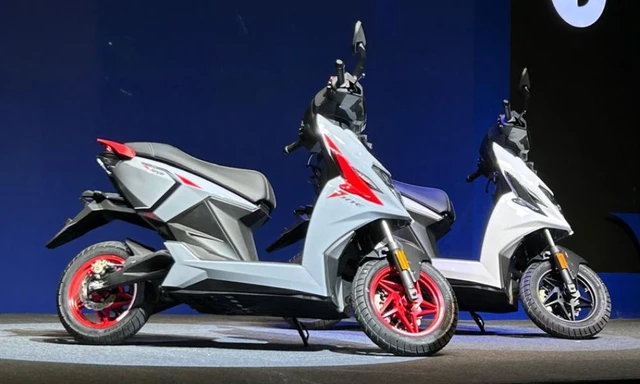Jeep Meridian vs Toyota Fortuner Comparison Review

Over the years, a few carmakers tried to squeeze into the 7-seater full-size luxury SUV space like the Mahindra Alturas G4, MG Gloster, and even the Volkswagen Tiguan AllSpace for that matter, but none managed to dent the supremacy of the Toyota Fortuner. The Ford Endeavour gave the Fortuner a tough fight for the longest time, before the company bowed out of the scene entirely, leaving the full-sized SUV segment to this Goliath. In comes the Jeep Meridian, a David in the truest form, with strong Jeep DNA, off-roading credentials and not to mention a distinct design that makes the American carmaker’s version of a 7-seater SUV stand out in a very sensitive segment. But can this David take on the Goliath that is the Toyota Fortuner?
Dimensions
In-person, both these SUVs look huge, and buff in proportions, and their size is indeed intimidating. However, comparing the dimensions, the Toyota Fortuner emerges as the clear victor. It has a marginal advantage in length-- 26 mm, and is significantly taller-- 137 mm, than the Meridian. But the Meridian has a longer wheelbase by 37 mm that helps the passengers inside with a little extra space to get comfortable. The Fortuner has a superior ground clearance though-- of 17 mm to be precise. Boot space is another aspect where the Fortuner has an upper hand. The only area where the Fortuner loses out is in terms of weight which is a good 364 kg heavier than the Meridian.
Design
As expansive as the Fortuner’s equipment list is, the car looks gorgeous. While its size is imposing, the front face looks quite sophisticated and futuristic. The side profile has a very prominent recessed area which helps with its character. The rear continues the flare at the back and looks well integrated with the front, almost like an extension.
The Meridian however has a clear-cut design approach. It looks imposing and aggressive. View it from any angle, and the Meridian oozes the same intimidating overview. Only the rear section is a little subtle compared to the rest of the vehicle. The flared wheel arches and the high-profile fat tyres make it look imposingly muscular which makes the SUV’s presence felt on the roads. Looks are subjective and the debates on social media will have polarising opinions, but Meridian looks sophisticated, and classy when compared to the Japanese!
Interior & Tech
The interior is surprisingly plush for a butch SUV like this. There are loads of creature comforts present inside which make it a quite welcoming experience. A special mention to that beautiful panoramic sunroof as well. Both the front seats are now ventilated and electrically adjustable and the good thing is that it's standard across the range. The 8.0-inch Smart Playcast Touchscreen Audio is quite responsive, but the interface could've been better, and a larger screen would’ve been ideal considering this massive cabin.
There’s Android Auto and Apple CarPlay but no wireless connectivity. Wireless charging is missing here. But it packs in connected car technology for the first time which means you get geofencing, real-time tracking, last parked location, etc.
The Meridian however has a swanky-looking cabin. The quilted leather-finish seats, and the colour palette in rich dark tones, do convey that to a certain extent. The plastics could have been better though. The panoramic sunroof, a 10.1-inch touchscreen, a 10.2-inch digital instrument cluster, ventilated power seats in front, power tailgate, and a few other comfort and tech features complement each other well. The best part is that all the above-mentioned features are standard. We have the Limited (O) version with us, and it is properly loaded.
It is also a connected car and features Jeep’s Uconnect suite with features like geofencing, remote door lock/unlock, etc. Wireless Apple CarPlay and Android Auto, besides a wireless phone charger, are a much-needed prerequisite nowadays.
Rear-Row Space
But most travel will occur from the second row. In the Fortuner, there is no option of captain seats, but the bench seat is quite big and gives you more than adequate comfort. The thigh support is decent and there's a good sense of space overall. All three headrests are adjustable, and you have a centre armrest and roof-mounted AC vents as well. The absence of a sunroof is a downer especially for a car at this price point, and a 12V charging socket also doesn’t help its cause.
Access to the third row is easy as the second-row seats recline, tumble, and slide forward. However, sitting here for long distances could prove to be a bit uneasy, especially for adults. It's only a consolation that the seats on the 3rd row recline to give you better headroom. You get AC vents and a charging spot for third-row passengers.
I have mixed feelings about the second row of the Meridian. The seats are positioned higher and so you automatically get more under-thigh support with a larger squab. The legroom, however, is not exactly at par with the Fortuner, and the extra wheelbase doesn’t really translate to the presumed roominess. Even the inability of the second row to slide is a shame. The large window and a panoramic sunroof are the only solace for longer journeys, further aided by reclinable seat backs. However, the seats aren’t as wide as we would’ve liked, and traveling with 3 adults is a bit of a squeeze.
The third row is quite disappointing though. The one-touch tumbles on second-row seats make it easy to access the last row, but the swooping roofline restricts your passage. A fair bit of wiggle is very much likely. Roof-mounted air-con vents keep you cool. But space is its biggest Achilles heel.
Engine/Gearbox
The Toyota Fortuner offers turbocharged versions of its petrol and diesel engines. The petrol version is available with 164 bhp @ 5,200 rpm, and 245 Nm @ 4,000 rpm, paired to a 4x2 system with both manual and automatic transmissions. The diesel version equips both 4x2 and 4x4 systems to its manual and automatic versions with a common 202 bhp @ 3,400 rpm but punches out different torque figures of 420 Nm @ 1,400 – 3,400 rpm and a massive 500 Nm @ 1,600 – 2,800 rpm respectively. The Legender, meanwhile, just gets a diesel 4x2 automatic variant.
The Jeep Meridian gets the Compass 2.0-litre turbo diesel engine with the option of a 6-speed manual or 9-speed automatic gearbox. Surprisingly, its state of tune is identical to the Compass diesel. It produces 168 bhp @ 3,750 rpm and 350 Nm @ 1750-2500 rpm. The difference in power on both these cars is massive, and we believe Jeep missed out on an opportunity to offer a more powerful version as well. There's loads of grunt and even more torque which is not the problem. But, a car of this size needs more power, and even more so when it must compete with a powerhouse on the other side of the ring. However, being the lighter one here does help.
City Drive
It was time to take both the cars out, and I first hopped into the Toyota Fortuner. Our test vehicle is the top-of-the-line diesel automatic version, but before heading to some tough terrains, we thought of driving the car around the city for a brief amount of time to get a hang of the car, because that’s going to be its primary duty. The power delivery is linear and engaging enough thanks to the three driving modes to choose from- Eco, Normal, and Sport modes, but it is the latter that gives you the full-blown experience as if summoned by the God Of Thunder, only figuratively though. Driving on the highway is a lot more enjoyable. The suspension setup works well for our conditions, and although body roll is still there, more so while cornering at high speeds, it takes time to get used to. Also, the new variable flow control steering, which is just offered with the diesel engine is a lot lighter and not as engaging as earlier.
With the Meridian, power delivery is restrained, but feels more responsive off the line. In fact, it is purposely tuned for a smoother drive while the lowered NVH levels allow a comfortable journey. But that doesn’t mean it doesn’t grunt, nor feels underpowered. The torquey unit has a nice tug available across the rev band with enough oomph to hurl you ahead with urgency, but the 9-speed gearbox cancels out any kind of spirited driving with its slow reaction to gear changes. In fact, it is more than ideal for highway cruising which it can do all day long, effortlessly. Stability on different surfaces is impressive and it doesn’t flinch while taking on broken roads.
Off-Road Dynamics
Speaking of broken roads, we have arrived at our location. We particularly chose this spot to test out the off-road cred of both these SUVs and thankful to the Rain Gods, there was enough slush to throw around. It was time to get dirty. Again, figuratively for me, but literally for the SUVs. A quick background check will tell you that both models get hill-descent control and four-wheel drive. The Fortuner and the Meridian, both went over slushy and boulder-laden off-road quite effortlessly. But there was a difference in the way they went about. The Fortuner felt the most sure-footed and rugged, crawling up rocks with surprising ease. The approach angle of 29 degrees and departure angle of 25 degrees helped a lot while making difficult maneuvers.
The Meridian too managed to keep up. It crossed everything the Fortuner crossed. And that too in Auto mode the whole time. Never did I require to try out the multiple drive modes- Sand/Mud, Snow. And that’s because most owners would stick to the default setting which maximises traction automatically depending on the surfaces, you’re on. But the Fortuner is a different beast. We spent a considerable amount of time here, but I spent most of mine in the Fortuner. That’s how much trust the car has earned over the years and is well deserved even. Meridian proved to be capable, too, though the low-end responses did require very precise flexing of the right foot.
Price
There’s no doubt that the Toyota Fortuner is an expensive proposition. Of course, it has more trims, a petrol version, and an even more powerful Legender version to choose from but once it goes on the road, the price seems to be on the higher end of the spectrum compared to what it offers. No doubt, the emotion behind owning a Fortuner is far superior to its price tag but with the Meridian in the picture now, you get an equally capable alternative at a much lower price.
Verdict
The Toyota Fortuner is the most popular SUV in India and is the default choice for many. The car has its strengths, it is hungry to perform, and a true off-road machine that isn’t scared to get its wheels dirty. Its high price tag doesn’t really scream out sophistication, but the Fortuner scores big for being a reliable product that is easy to own and promises good resale value. The Meridian on the other hand blends on-road and off-road dynamics seamlessly, and still has enough left in it to attend a Gala event in the evening.
It also makes for a brilliant companion on long distances, irrespective of how good or bad the road surface is. Although the lack of a petrol option precludes a section of buyers who have moved away from diesel, Jeep’s ownership packages will sweeten the deal. Big on substance, the Meridian seems poised to upset the established order by claiming the bragging rights to this comparison.
Photography by: Apoorv Choudhary
Latest News
 Jaiveer Mehra | Jan 6, 2026Mahindra XUV 3XO EV Launched In India; Prices Start At Rs 13.89 LakhEssentially the successor to the XUV 400 EV, the 3XO EV is offered in two trim levels and solely with a 39.4 kWh battery.1 min read
Jaiveer Mehra | Jan 6, 2026Mahindra XUV 3XO EV Launched In India; Prices Start At Rs 13.89 LakhEssentially the successor to the XUV 400 EV, the 3XO EV is offered in two trim levels and solely with a 39.4 kWh battery.1 min read Jaiveer Mehra | Jan 6, 2026Nissan Tekton SUV World Premiere On February 4The Tekton will make its debut hot on the heels of the Gravite and will share its platform with the upcoming new Duster.1 min read
Jaiveer Mehra | Jan 6, 2026Nissan Tekton SUV World Premiere On February 4The Tekton will make its debut hot on the heels of the Gravite and will share its platform with the upcoming new Duster.1 min read car&bike Team | Jan 6, 2026New Bajaj Chetak With Hub Motor To Be Launched On January 14Expected to be positioned as a more affordable derivative of the iconic Bajaj scooter, the newest member of the Chetak family will be targeted at the TVS Orbiter and Vida VX2.2 mins read
car&bike Team | Jan 6, 2026New Bajaj Chetak With Hub Motor To Be Launched On January 14Expected to be positioned as a more affordable derivative of the iconic Bajaj scooter, the newest member of the Chetak family will be targeted at the TVS Orbiter and Vida VX2.2 mins read Jaiveer Mehra | Jan 6, 2026Nissan Gravite MPV To Debut On January 21B-segment MPV to share its underpinnings and powertrain options with the Renault Triber.1 min read
Jaiveer Mehra | Jan 6, 2026Nissan Gravite MPV To Debut On January 21B-segment MPV to share its underpinnings and powertrain options with the Renault Triber.1 min read Jaiveer Mehra | Jan 6, 2026Mahindra XUV 7XO Prices, Variants ExplainedFacelifted SUV is offered in a choice of six variants and with petrol and diesel engine options.1 min read
Jaiveer Mehra | Jan 6, 2026Mahindra XUV 7XO Prices, Variants ExplainedFacelifted SUV is offered in a choice of six variants and with petrol and diesel engine options.1 min read car&bike Team | Jan 5, 2026Updated Simple One Electric Scooter Launched At Rs 1.50 Lakh; 5 kWh Variant Promises Up To 265 KM RangeWith a series of changes made to the existing scooter, the start-up claims to have improved range, top speed as well as on-road behaviour of the Simple One.1 min read
car&bike Team | Jan 5, 2026Updated Simple One Electric Scooter Launched At Rs 1.50 Lakh; 5 kWh Variant Promises Up To 265 KM RangeWith a series of changes made to the existing scooter, the start-up claims to have improved range, top speed as well as on-road behaviour of the Simple One.1 min read
 Amaan Ahmed | Jan 3, 2026VLF Mobster 135 300 KM Review: Fun But FlawedA 125 cc scooter with Italian design and Chinese genes is a rare combination, and while some may be tempted to dismiss it because of its origins, the VLF Mobster shows 125s can also be exciting – but not without compromises.11 mins read
Amaan Ahmed | Jan 3, 2026VLF Mobster 135 300 KM Review: Fun But FlawedA 125 cc scooter with Italian design and Chinese genes is a rare combination, and while some may be tempted to dismiss it because of its origins, the VLF Mobster shows 125s can also be exciting – but not without compromises.11 mins read Preetam Bora | Dec 30, 2025TVS Orbiter Review: Real-World Performance and Range TestedThe TVS Orbiter is a promising electric scooter promising decent range, practicality and pricing. But is there any reason to avoid it? We spent a few days getting to know it better.9 mins read
Preetam Bora | Dec 30, 2025TVS Orbiter Review: Real-World Performance and Range TestedThe TVS Orbiter is a promising electric scooter promising decent range, practicality and pricing. But is there any reason to avoid it? We spent a few days getting to know it better.9 mins read Jafar Rizvi | Dec 24, 2025MG Windsor EV 38 kWh Long-Term Report: IntroductionThe Windsor EV has joined our garage, and before it settles into daily duty, I took it out to get a sense of what living with an electric car is like.4 mins read
Jafar Rizvi | Dec 24, 2025MG Windsor EV 38 kWh Long-Term Report: IntroductionThe Windsor EV has joined our garage, and before it settles into daily duty, I took it out to get a sense of what living with an electric car is like.4 mins read Seshan Vijayraghvan | Dec 23, 20252026 Kia Seltos Review: Formula Is Spot On, But Is The Timing Right?The 2nd-gen Kia Seltos has arrived, but it has the challenge of facing strong rivals like the Victoris and Sierra. The question is simple - Does it still have what it takes?9 mins read
Seshan Vijayraghvan | Dec 23, 20252026 Kia Seltos Review: Formula Is Spot On, But Is The Timing Right?The 2nd-gen Kia Seltos has arrived, but it has the challenge of facing strong rivals like the Victoris and Sierra. The question is simple - Does it still have what it takes?9 mins read car&bike Team | Dec 26, 2025Tata Punch EV Long-Term Second Report: Highway Performance, Pros & ConsAfter a week of living with the Tata Punch EV Long Range—including a proper Mumbai-Nashik highway test—we've learned what this little electric SUV is really made of.1 min read
car&bike Team | Dec 26, 2025Tata Punch EV Long-Term Second Report: Highway Performance, Pros & ConsAfter a week of living with the Tata Punch EV Long Range—including a proper Mumbai-Nashik highway test—we've learned what this little electric SUV is really made of.1 min read























































































































